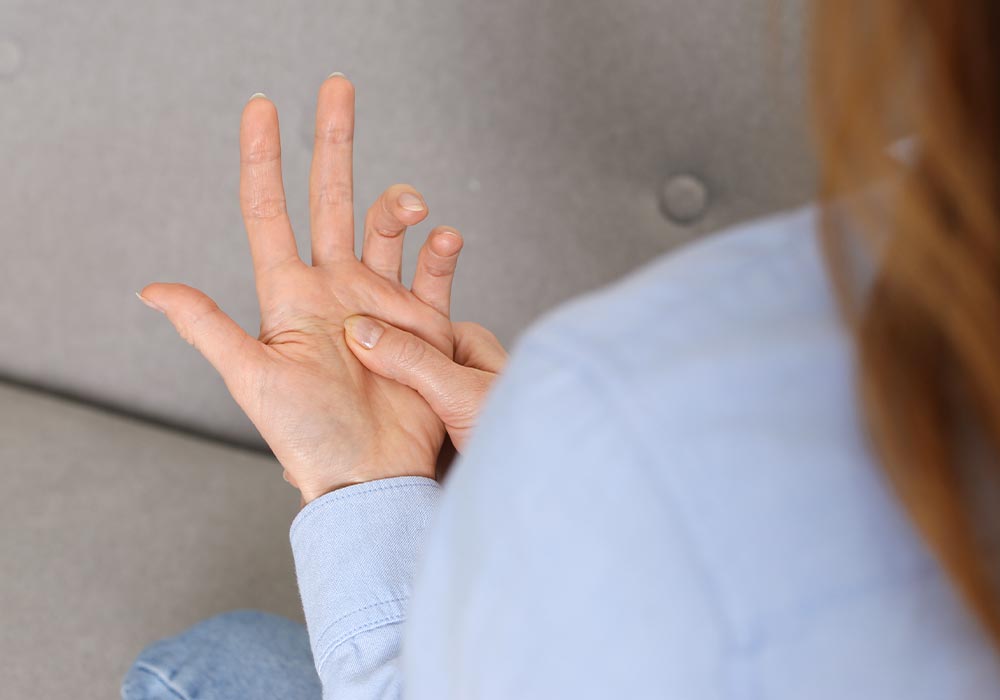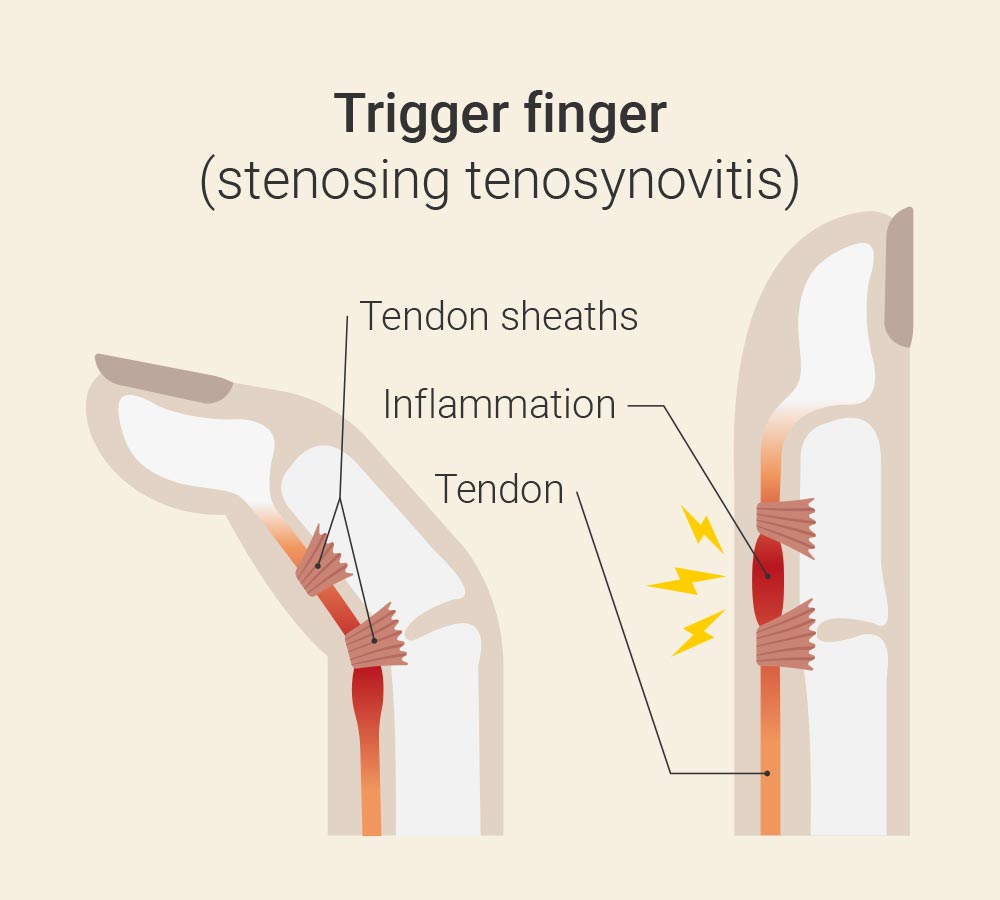Does a finger hook, is it difficult or painful to stretch? This symptom may indicate a “trigger finger”. The finding can have a considerable impact on everyday life and is often very unpleasant for those affected. But how can hand tendon disorders be treated effectively? Below we show you the various options that can help you regain pain-free and unrestricted use of your hands.

What is trigger finger?
Known in medical terminology as tendovaginitis stenosans, trigger finger is a functional disorder of the hand that impairs the smooth movement of one or more fingers. The condition occurs when the flexor tendons of a finger can no longer slide freely through their gliding channel, which is stabilized by so-called annular ligaments.

How a trigger finger develops
Imagine the tendons as cords that slide through tight-fitting tubes (the tendon sheaths). These tubes are in turn fixed to the bone by ring ligaments to keep the tendons close to the finger. The following happens with the trigger finger:
- Thickening of the tendon
Overloading, irritation or inflammatory processes can cause the flexor tendon to thicken at a certain point. Sometimes a small nodule also forms there. - Narrowing of the annular ligament/tendon sheath
At the same time or in addition, the annular ligament, under which the tendon has to glide, can become inflammatory narrowed or thickened. The A1 annular ligament at the base joint of the finger is most frequently affected.
This combination of thickened tendon and/or narrowed canal prevents the tendon from gliding smoothly through the canal. When attempting to flex or extend the finger, the thickened tendon or the nodule gets caught on the annular ligament. If sufficient force is applied, the tendon “snaps” through the constriction, causing the characteristic sound and sensation.
Underlying diseases such as diabetes mellitus, gout or rheumatism can also promote the development of the condition.
Typical symptoms of a trigger finger
The symptoms often develop gradually and can vary:
- Snapping/jerking
The most noticeable indication is the typical “snapping”, “jumping” or “clicking” of the affected finger when bending or stretching. - Pain
In addition, there is often pain in the area of the metacarpophalangeal joint (on the palm of the hand), which can become worse when moving. - Morning stiffness
Many sufferers notice stiffness in the finger, especially in the morning. - Blockage
In advanced stages, the finger can “jam” in a bent position. This means that you can no longer stretch it independently. To release the finger from the blockage, you often have to help with the other hand. - Palpable thickening
Sometimes a small, painful thickening can be felt on the palm of the hand above the affected metacarpophalangeal joint.
A trigger finger can affect any finger. However, the thumb, middle finger and ring finger are most commonly affected. Statistically, women are affected more frequently than men and the condition is more common in middle age.
Different stages of a snap finger
Stage 1: Pain and tenderness
- In this initial stage, you primarily feel pain and tenderness in the palm of the hand, directly above the A1 annular ligament at the base joint of the finger.
- There is no snapping or sticking of the finger yet. Mobility is usually almost unrestricted.
Stage 2: Snapping symptoms
- Now there is the characteristic snapping or jerking of the finger when bending or stretching.
- The finger can still be fully extended using its own strength (active), even if this may be associated with noticeable resistance.
Stage 3: Blockage, passively correctable
- In this stage, the finger is locked in a bent position and can no longer be stretched under its own power.
- However, you can bring the finger back into position with the help of the other hand (passively), although this is often associated with pain.
Stage 4: Fixed blockage
- This is the most advanced stage. The finger is fixed in a bent position and cannot be fully extended either actively or passively (i.e. not even with the help of the other hand). A permanent flexed position has developed.
Snap finger treatment: How we can help you
Determining the exact stage is crucial for treatment planning. In the early stages (1 and 2), conservative treatment approaches are often successful. The further the disease progresses and the higher the stage, the more likely it is that surgery will be necessary to permanently correct the problem.
Conservative snap finger treatment in our practice in Frankfurt
Conservative therapy aims to alleviate symptoms without surgery. The aim is to reduce inflammation and promote the smooth gliding of the tendon. It is particularly suitable for early stages. Important measures include
- Rest and activity adjustment
Avoid movements that cause pain and adjust gripping patterns. - Splint treatment
A splint (for the night) immobilizes the finger and relieves the tendon. - Drug therapy
NSAID painkillers relieve inflammation and pain. - Cortisone injections
A direct injection into the tendon sheath is very effective in reducing swelling. A single injection is often sufficient for long-lasting improvement. - Physiotherapy/hand therapy
Targeted exercises and manual techniques improve mobility and tendon gliding ability. - Treatment of underlying diseases
In addition, good control of diseases such as diabetes is important for the success of the therapy.
Surgical snap finger treatment in Frankfurt
If conservative measures are not sufficient or the condition is already advanced, surgery is advisable. The aim of the procedure is to remove the bottleneck that is causing the finger to snap or lock.
- The procedure: Ring ligament splitting
Snap finger surgery is usually performed on an outpatient basis in our private practice for orthopaedics and traumatology in Frankfurt. You will be given a local anesthetic. This means that only your hand or the affected finger will be anaesthetized. You will remain awake during the entire procedure. We will make a small incision about 1 to 2 centimetres long on the palm of your hand, directly above the affected metacarpophalangeal joint. Under direct vision, we carefully split the thickened A1 annular ligament lengthwise. In this way, we widen the gliding channel for the flexor tendon. The tendon can then glide unhindered and pain-free through the exposed channel again. We then suture the skin wound with a few stitches. - After the operation
You can usually move your finger freely again immediately after the operation. A bandage protects the wound. Swelling and slight pain are normal and can be easily controlled with painkillers. We remove the stitches after 10 to 14 days. Until then, you should keep the wound clean and dry. It is important to move the finger early and regularly to avoid adhesions. Targeted fist-closing and stretching exercises promote full mobility.
Your path to recovery: diagnostics and treatment in Frankfurt
Regardless of whether you notice the first signs of a trigger finger or are already suffering from more severe symptoms: A precise diagnosis and treatment tailored to your situation are crucial for your hand health.
With many years of experience and in-depth expertise in the field of hand surgery, we offer you comprehensive advice and all common conservative and surgical treatment options for snap finger.
Simply contact us to arrange an appointment!
500875614 © New Africa | 304386780 © barks | stock.adobe.com